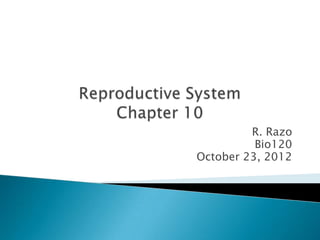
Bio 120 ch10 reproductive system
- 1. R. Razo Bio120 October 23, 2012
- 2. During this time the uterine muscle contracts strongly to expel the fetus In this process the fetus presses on the cervix and causes it to dilate
- 3. Labor is the actual process of expelling the fetus from the uterus and through the vagina It begins with uterine contractions (ends with the birth of the baby, Stage three) This stage is usually the longest stage, lasting about 12-19 hours
- 4. Contractions become stronger and at regular and increasing intervals Lower back pain and cramping Your water breaks (a large gush or a continuous trickle) You have a bloody (brownish or red-tinged) mucus discharge; this is probably the mucus plug that blocks the cervix; this is usually a sign that the cervix is dilating
- 5. EFFACEMENT Thinning of the cervix during labor, Occurs as the cervix dilates At this point, the cervix is completely dilated to 10 cm.
- 6. This stage usually lasts 20 minutes to two hours; you will push hard during contractions and rest between contractions When the top of the baby’s head fully appears (crowning), the doctor will tell you to push and deliver the baby The doctor may make a small cut (episiotomy) to enlarge the vaginal opening After the baby is born, the umbilical cord is cut
- 7. Also called afterbirth, the placenta is attached to the uterine wall that is composed of maternal and fetal tissues The baby is attached to the placenta by way of the umbilical cord Immediately following childbirth, the uterus continues to contract, thus the placenta is expelled through the vagina Labor is over once the placenta is delivered.
- 9. One of the longest terms used in medical terminology Refers to the removal of the uterus, cervix, ovaries, and fallopian tubes Salpingo-oophorectomy is the removal of the ovary and its adjacent Fallopian tube. Oophorectomy is the surgical removal of the ovary(s) Source; www.medicinenet.com/hysterectomy
- 10. These two procedures are performed for: Ovarian cancer Removal of suspicious ovarian tumors Fallopian tube cancer (which is very rare) They may also be performed due to complications of infection, or in combination with hysterectomy for cancer Source: www.medicinenet.com/hysterectomy
- 11. Sometimes, women with inherited types of cancer of the ovary or breast will have an oophorectomy as preventive surgery in order to reduce the risk of future cancer of the ovary or breast. Source: www.medicinenet.com/hysterectomy
- 12. The ending of menstrual activity and childbearing years Age is the leading cause of menopause, and usually occurs between the ages of 40 and 55 It is brought on by the ovaries gradually slowing down their function Certain surgeries and medical treatment can induce menopause (examples are bilateral oopharectomy and chemotherapy Source: www.medicinenet.com/menopause_and_perimenopause
- 13. Women who smoke tend to go through menopause a few years earlier than nonsmokers There is no proven way to predict menopause age Menopause can be confirmed only after a woman has missed her periods for 12 consecutive months (without other obvious causes) Source: www.medicinenet.com/menopause_and_perimenopause
- 14. The transition to menopause is called perimenopause During perimenopause, it's still possible for a woman to get pregnant Although a woman’s periods may become more unpredictable, her ovaries are still functioning and she still may ovulate Source: www.medicinenet.com/menopause_and_perimenopause
- 15. Menopause Symptoms May Include: Hot Flashes - a brief feeling of heat that may make the face and neck flushed Hot flashes vary in intensity and typically last between 30 seconds and 10 minutes Sex Problems - Less estrogen can lead to vaginal dryness, which may make intercourse uncomfortable or painful Source: www.medicinenet.com/menopause_and_perimenopause